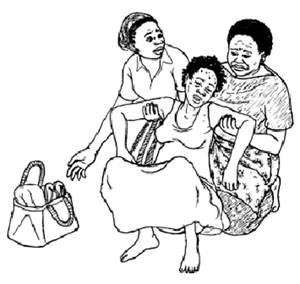21.5 What to do for a woman with late pregnancy bleeding
If you detect late pregnancy bleeding and you suspect placental abruption, placenta previa, a ruptured uterus or bleeding from any other cause, take the following steps:
- Never perform a vaginal examination
- Make a rapid evaluation of the general condition of the woman, including vital signs: pulse, blood pressure, respiration and temperature; check her for pallor, weakness, dizziness and confusion.
- If you suspect shock, begin treatment immediately by starting a rapid intravenous (IV) infusion with Normal Saline or Ringer’s Lactate solution. (You will learn the theory of how to do this in Study Session 22 and develop this competency in your practical skills training.)
- Even if signs of shock are not present, keep shock in mind as you evaluate the woman further because her status may worsen rapidly. If shock develops, take the actions described above.
- Urgently mobilise all available people who can help, inform them how serious the situation is and put into action the complication readiness plan you developed with the woman and as part of focused antenatal care (Study Session 15 of this module). For example, get the village people to assist with transporting her quickly to the higher health facility; make sure that healthy people go with her who can donate blood if she requires a blood transfusion.

Remember that the initial bleeding could be heavy and life-threatening and the woman may arrive at your Health Post carried by relatives. In such a situation, after you do a quick assessment of the condition of the patient, put up the IV line, organise transport and send the woman to the nearest higher health facility as soon as possible.
What is the safest position in which to transport the woman? (Think back to Figure 20.3 in the previous study session.)
Her head should be lying flat — don’t put a pillow under her head. Raise her knees and support her legs with pillows or rolled blankets, so her feet are higher than her head.
 In the case of late pregnancy bleeding, even if the bleeding stops on its own before labour begins, the woman should always be referred and preferably deliver her baby in a higher health facility.
In the case of late pregnancy bleeding, even if the bleeding stops on its own before labour begins, the woman should always be referred and preferably deliver her baby in a higher health facility.
Ideally, you should accompany her to maintain the IV infusion and keep the bag of IV fluid held above her. If you cannot go with her, explain the importance to whoever accompanies her of keeping the woman and the fluid bag in the suggested positions; also tell them how to close the IV tubing when the bag of fluid has completely drained. Remember to send a referral note with the woman.
In the final study session in this Module, we teach you the theory of how to set up an intravenous infusion, and also how to insert a urinary catheter in a woman who is unable to urinate due to complications of pregnancy or labour.
21.4 Ruptured uterus
